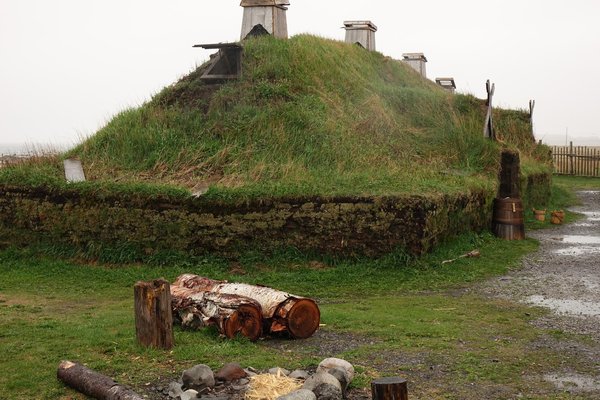Canada
L'Anse aux Meadows
L’Anse aux Meadows National Historic Site comprises the remains of the only known site of Viking settlement and the earliest European settlement in North America outside of Greenland.
It was a year-round base camp for the exploration and exploitation of resources desirable in Greenland. The settlement – with space for 70 to 90 people - was established in the early 11th century and abandoned about a decade later. The site contains the remains of eight timber-framed turf buildings, including an iron-smelting hut, in a similar style to those in Norse Greenland and Iceland.
Community Perspective: the site is located at the very tip of Northwest Newfoundland and you may spot icebergs floating by. Despite its remote location it is well-geared to receive tourists and offer them something to see and learn beyond the unassuming earthen mounds that hold the original remains.
Site Info
Official Information
- Full Name
- L'Anse aux Meadows National Historic Site (ID: 4)
- Country
- Canada
- Status
-
Inscribed 1978
Site history
History of L'Anse aux Meadows
- 2000: Name change
- From "L'Anse aux Meadows National Historic Park" to "L'Anse aux Meadows National Historic Site"
- 1978: Inscribed
- Inscribed
- Type
- Cultural
- Criteria
- vi
Links
- UNESCO
- whc.unesco.org
- Official
-
- pc.gc.ca — Parks Canada
- Related
-
- newfoundlandlabrador.com — Newfoundland tourism website
- thecanadianencyclopedia.ca — The Canadian Encyclopedia
- en.wikipedia.org — Wiki on L'Anse aux Meadows
All Links
UNESCO.org
- whc.unesco.org — whc.unesco.org/
Official Website
- pc.gc.ca — Parks Canada
Related Resources
- newfoundlandlabrador.com — Newfoundland tourism website
- thecanadianencyclopedia.ca — The Canadian Encyclopedia
- en.wikipedia.org — Wiki on L'Anse aux Meadows
- journals.lib.unb.ca — The Norse in Newfoundland
- heritage.nf.ca — The Norse in the North Atlantic
News Article
- Oct. 21, 2021 smithsonianmag.com — New Dating Method Shows Vikings Occupied Newfoundland in 1021 C.E.
- Aug. 2, 2012 thestarphoenix.com — Statue centrepiece of historic L'Anse aux Meadows makeover
Community Information
- Community Category
- Archaeological site: Viking
Travel Information
Recent Connections
-
Viking Cultural Route
-
Perfect Inscriptions
1978 -
Iron production
The fourth complex, an iron-smelting hu…
Connections of L'Anse aux Meadows
- Geography
-
-
Atlantic Ocean
At the Straight of Belle Isle, which is an outlet for the Gulf of St. Lawrence, the outlet of the North American Great Lakes via the St. Lawrence River into the Atlantic Ocean. (OUV)
-
- History
-
-
Historical Food Remains
Butternuts
-
- Ecology
- Architecture
-
-
Wooden architecture
"consists of eight timber-framed turf structures" (OUV)
-
- World Heritage Process
-
-
Perfect Inscriptions
1978 -
Inscribed on a single criterion only
vi. to be directly or tangibly associated with events or living traditions, with ideas, or with beliefs, with artistic and literary works of outstanding universal significance. (The Committee considers that this criterion should preferably be used in conjunction with other criteria) -
WHS inscribed solely on Criterion VI
-
Minor modifications after inscription
2017: reduction of the boundaries, linked to the Beak Point area, which is wrongly part of the World Heritage property -
First inscriptions
Canada: two inscriptions in 1978, with L'Anse aux Meadows National Historic Site as the first recorded and with the lowest number
-
- Human Activity
-
-
Iron production
The fourth complex, an iron-smelting hut, was built into the brook bank, closer to the shore. This open-ended hut sheltered a small stone-and-clay furnace where iron was smelted from small deposits of ore found in bogs. -
Viking settlements
the first and only known site established by Vikings in North America and the earliest evidence of European settlement in the New World (OUV)
-
- WHS on Other Lists
-
-
Viking Cultural Route
-
ASM Historical Landmarks
L'Anse aux Meadows (2003)
-
- Timeline
-
-
Built in the 11th century
The settlement at L'Anse aux Meadows has been dated to approximately 1000 years ago, an assessment that agrees with the relative dating of artifact and structure types. This is about the same time as the establishment of Vinland (1003)
-
News
- smithsonianmag.com 10/21/2021
- New Dating Method Shows Vikings Oc…
- thestarphoenix.com 08/02/2012
- Statue centrepiece of historic L'A…
Recent Visitors
Visitors of L'Anse aux Meadows
- Adam Hancock
- Alex Goh
- ALS
- Ana Lozano
- Anne
- Antonio J.
- Argo
- Atila Ege
- Birgitte Sørensen
- Brett Baumann
- brornt
- Casey
- CynthiaW
- dave wood
- David Aaronson
- David Scott King
- Ellen Nielsen
- Els Slots
- Feldhase
- Frédéric M
- FS
- Gary Arndt
- George Gdanski
- GeorgeIng61
- Iain Jackson
- Jacob Choi
- Jawnbeary
- Jay T
- Jeanne OGrady
- J_neveryes
- Jonas Kremer
- JR's HERITAGE SITES
- Kayimi
- KeithBailey
- Kelly Rogers
- Lameduck99
- Lara Adler
- Lillybett
- Lithobates
- Ludvan
- Luis Filipe Gaspar
- maryhattie
- MH
- Michael Ayers
- Michael Novins
- Mihai Dascalu
- Mstrebl1990
- Nihal Ege
- Nolan B.
- Piotr Wasil
- Randi Thomsen
- Roger Ourset
- Roman Bruehwiler
- Rosemary
- Svein Elias
- Szucs Tamas
- Thomas Buechler
- Thomas van der Walt
- Tim Allen
- Timothy C Easton
- Tom Flaten
- Vsacan
- Waxwing
- Wojciech Fedoruk
- ZCTLife
- Zoë Sheng
Community Reviews
Show full reviews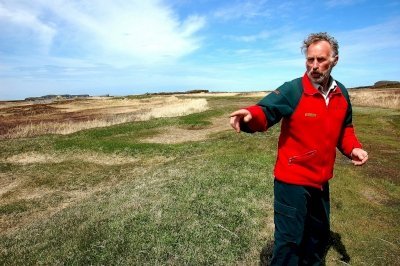
Even I don't know why I have such an affection for this site, which is really just a number of grassy mounds and depressions on the ground. Perhaps it is due to nostalgia because I, like most Canadians who grew up with TV rather than internet, watched Heritage Minutes during commercial breaks. Or perhaps it is due to the idea that near here, two groups of people encountered each other again after migrating away from each other 16,000 to 20,000 years earlier. Due to L'Anse aux Meadows's remote and wild setting, perhaps one can easily visualize that encounter from these mere mounds and depression.
At the site, a helpful Parks Canada guide (photo) will explain the various archaeological mounds and depression. You can also visit a recreated Norse dwellings within the historic site. If you want to experience more recreated Norse structures, then you can visit the Norstead Viking Village about 2 kilometres away.
Newfoundland and Labrador is one of my favourite places in the world. Its rugged beauty is magical, but due to its remoteness, it's not a place that you can easily fit into your Canadian travel itinerary unless you either have a lot of time or just want to focus on the Atlantic provinces. If you are travelling in western Newfoundland and Labrador, however, you should be able to fit three UNESCO World Heritage Sites, that is to say, L'Anse aux Meadows, Red Bay Basque Whaling Station, and Gros Morne National Park.
Keep reading 0 comments
Sometimes you think it is all a hoax. That the Canadian Tourist Board has made up this “Meeting of Two Worlds” site on the northwestern tip of Newfoundland to pull tourists to an economically disadvantaged part of the country. For WH travellers it is even worse, as L’Anse Aux Meadows has to be combined in one itinerary with Mistaken Point which lies completely on the opposite side of the island on its southeastern tip. The distance between them is 1150 kilometers.
The conclusion that this wasn’t an indigenous camp but one inhabited by early European navigators is attributed to the discovery of iron objects and a particular pin used in Scandinavia to hold together clothes (pictured). But what if the overeager Norwegian couple that rediscovered the site in 1960 had planted those just to prove what they were looking for all along?
I visited on June 20th – and it was cold (4 degrees Celsius), rainy, foggy and miserable overall. The contours of the Norse constructions looked like duck ponds. Luckily they had a fire going on in the main reconstructed turf house, where three local men half-heartedly tried to reenact Norse life around the year 1021. Even the fire turned out to be fake – it runs on propane gas.
Despite the misery, I was far from the only visitor, the site is right on the itinerary of the many elderly Canadians who explore their country by (huge) campervans. To pamper yourself afterwards, have lunch or …
Keep reading 0 comments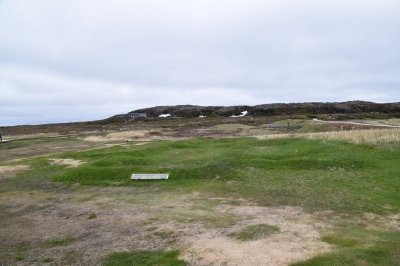
L’anse aux Meadows is really a just small community right next to the site where the Norwegian Leiv Eiriksson and his men first time set foot round 1000 A.D. It’s a 5-6 hour drive from Red Bay (waiting time for ferry Blanc Sablon - Saint Barbe) and it’s a very pleasant drive (except for the potholes). On a chilly June day, we arrived at the very northern tip of Newfoundland which has an arctic climate. Even though we were coming from a couple of days in Red Bay Labrador this environment seemed kind of tougher and harsher. A thousand years ago though they say the climate was much warmer, so the Norse travelers might have had an another experience. They came to a continent of opportunities and make contact with the locals which must have been a challenge. They came back several times and just maybe they tied to settle, but no permanent settlement lasted.
The visitor center is very informative and visual and it has a good 20 minute informative film telling the story of the Vikings and their visit in Helleland, Markland and Vinland introducing the concept Completion of the circle. Humans have for thousands of years been migrating from the origin in Africa through Europe and Asia, across the American continent all the way to the Atlantic coast. With the Viking voyage the humans completed the full circle around the globe.
The site itself is not very scenic. There is little to see at first …
Keep reading 0 comments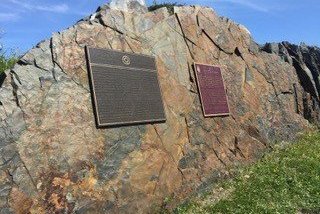
L'Anse aux meadows lies at the very tip of Northwest Newfoundland. Nearby is the small town of St. Anthony, where we saw several icebergs and met some bikers, who were also exceptionally friendly and personable, like all Newfoundlanders.
The Viking site of L’Anse aux Meadows is scenic, enabling you to believe that the Norse chose it partly for its beauty. Three icebergs were visible in the distance. Tall grasses, tiny wildflowers and horizontal forests brought Mistaken Point to mind. The Visitor’s Centre was beautifully done and informative with a lovely Viking ship replica. The UNESCO Plaque is very impressive!
On the long but easily walkable path, there was not much left of the actual Viking remnants, marked with red flags or they might have been missed, and they had a model of what the village might have looked like in days of yore. Further on were replicas of what the town might have looked like with various buildings, such as an outhouse, a slave room, a blacksmith room and other areas with costumed people walking about. The roofs were rustic and nicely done with great woodwork, but in general, this part of the site rang a bit false.
To get to the site, just take the Viking trail (route 430) to the end, which is a long, beautiful drive. The journey is 5 hours from Gros Morne, and it is well marked and easy to find. Some people recommended staying in St. Anthony as it is inexpensive, …
Keep reading 0 comments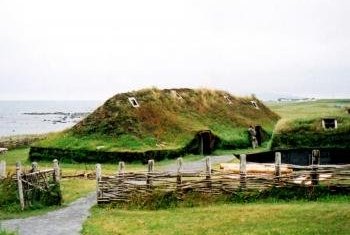
Around 1000 AD a group of Vikings established a village on the northern peninsula of Newfoundland in an area now called L'Anse aux Meadows -- a pre-Columbian European settlement in the western hemisphere commemorated in exactly zero national holidays in North America. This historical event was not forgotten by UNESCO (or Canada), however, and L'Anse aux Meadows was selected as one of the first 12 World Heritage Sites in 1978. After I learned about this Viking settlement in North America in school, I made sure to visit when I took a road trip with my father through Atlantic Canada in summer 2006. The museum at L'Anse aux Meadows offered a comprehensive and informative history of viking exploration in North America, but the highlight of the visit was the archaeological site outside the museum. All that remains of the village are mounds where buildings used to stand; however, sod houses from the settlement have been recreated, and Viking interpreters offer tours explaining how Norsemen lived 1,000 years in the past. It takes a considerable effort to travel to L'Anse aux Meadows, but the Viking history on display and the extremely scenic coastlines of Newfoundland make this an unforgettable site to visit.
Logistics: L'Anse aux Meadows requires an automobile to visit. The settlement is approximately five hours north of Deer Lake Regional Airport and at least seven hours north of the Port aux Basques ferry terminal on Newfoundland.
Keep reading 0 comments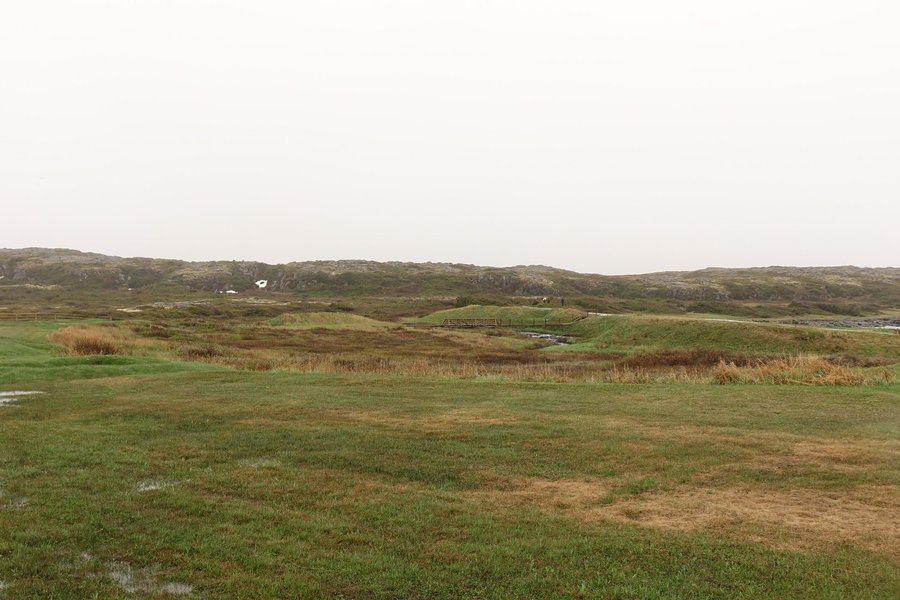
I first heard about Dr. Instad's excavations of a possible Norse site in the New World in "newsreels" (remember those!)in 1960 when I was 14. I knew at that moment that I HAD to make a pilgrimage there one day - and so I did so in 2007 to celebrate my 60th birthday. It was fascinating to walk through the ruins and look out on the Bay and see what the Norse saw 1000 years ago, and to realize that Lief Ericson had been here. The Visitor Center was excellent, as was the hospitality of the local people we met. I only wish the Museum/Visitor Center had small replicas of the sculpture commemorating the contact between the Norse and Native Americans-representing the final leg of the circumnavigation of the globe that had taken place starting with Homo sapiens' African Diaspora ~60,000 years ago.
On the way back to the U.S. Gros Morne national park was a geological wonderland.
I'm definitely going back - this time with bicycle, kayak and camping gear on my Element.
--Glenn Chinery, GChinery@aol.com
Keep reading 0 comments
My husband and I went here in August 2005 and were greatly surprised by the well-organized Visitor Centre and knowledgeable tour guides. Make sure to watch the film regarding the site's discovery by Dr. Helge Ingstad and his wife, Dr. Anne Stine. A meal at the nearby Norseman Restaurant is also a must!
Keep reading 0 comments
Visited in May, 2004 and even though the Visitor's Center was still closed, we were able to tour the huts and wander the coastline. The site in Newfoundland is allegedly where Lief Ericcson landed from Greenland. 2 sod huts have been completely restored and authentically furnished. A blacksmith's hut is also restored. The foundations of 6-8 other huts remain. The coastline is spectacular complete with mammoth icebergs, rocky cliffs and unusual plant life. Lots of reasonable places to stay in St. Anthony and the drive up from Gros Morne while 5 hours is beautiful.
Keep reading 0 comments
